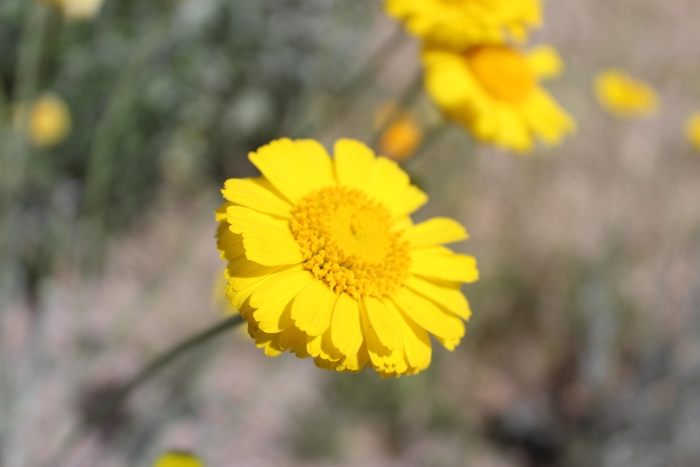Desert Marigold
(Baileya multiradiata)
Desert Marigold (Baileya multiradiata)
/
/

Isaac Krone
CC BY 4.0
Image By:
Isaac Krone
Recorded By:
Copyright:
CC BY 4.0
Copyright Notice:
Photo by: Isaac Krone | License Type: CC BY 4.0 | License URL: http://creativecommons.org/licenses/by/4.0/ | Rights Holder: Isaac Krone | Publisher: iNaturalist | Date Created: 2017-03-17T16:18:10-07:00 |



























































Estimated Native Range
Summary
Baileya multiradiata, commonly known as Desert Marigold, is a perennial herb that can behave as an annual in harsh conditions, native to arid deserts and semi-desert grasslands of the Southwestern United States and northern Mexico, including Sonora, Chihuahua, Coahuila, Durango, Aguascalientes, California, Arizona, Nevada, Utah, New Mexico, and Texas. It typically forms clumps reaching 1 to 2 feet in height and width, with silvery-green foliage that provides a striking contrast to its bright yellow, daisy-like flower heads. The flowers bloom from early spring to fall, with peak flowering in spring, and are highly attractive to pollinators such as bees and butterflies.
Desert Marigold is valued for its drought tolerance and ability to thrive in poor, well-drained soils, making it an excellent choice for xeriscaping and rock gardens. It prefers full sun exposure and requires minimal water once established, embodying the ideal of low-maintenance gardening. While it is not commonly used for culinary or medicinal purposes, its showy flowers and silver foliage make it a popular ornamental plant in arid landscape designs. Gardeners should be aware that Baileya multiradiata can self-seed prolifically under ideal conditions, which can be managed by deadheading spent flowers to prevent unwanted spread.CC BY-SA 4.0
Desert Marigold is valued for its drought tolerance and ability to thrive in poor, well-drained soils, making it an excellent choice for xeriscaping and rock gardens. It prefers full sun exposure and requires minimal water once established, embodying the ideal of low-maintenance gardening. While it is not commonly used for culinary or medicinal purposes, its showy flowers and silver foliage make it a popular ornamental plant in arid landscape designs. Gardeners should be aware that Baileya multiradiata can self-seed prolifically under ideal conditions, which can be managed by deadheading spent flowers to prevent unwanted spread.CC BY-SA 4.0
Plant Description
- Plant Type: Herb
- Height: 1-1.5 feet
- Width: 1.5-2 feet
- Growth Rate: Rapid
- Flower Color: Yellow
- Flowering Season: Summer, Fall
- Leaf Retention: Semi-Deciduous
Growth Requirements
- Sun: Full Sun
- Water: Low
- Drainage: Fast
Common Uses
Bee Garden, Drought Tolerant, Groundcover, Low Maintenance, Rock Garden, Showy Flowers
Natural Habitat
Native to arid deserts and semi-desert grasslands
Other Names
Common Names: Showy Desert Marigold, Paper Daisy, Desert Baileya, Wüstenmargerite
Scientific Names: , Baileya multiradiata, Baileya multiradiata var. multiradiata, Baileya multiradiata var. thurberi, Baileya thurberi, Baileya australis, Baileya multiradiata var. nudicaulis, Baileya pleniradiata var. multiradiata, Baileya pleniradiata var. thurberi,
GBIF Accepted Name: Baileya multiradiata Harv. & Gray ex Torr.